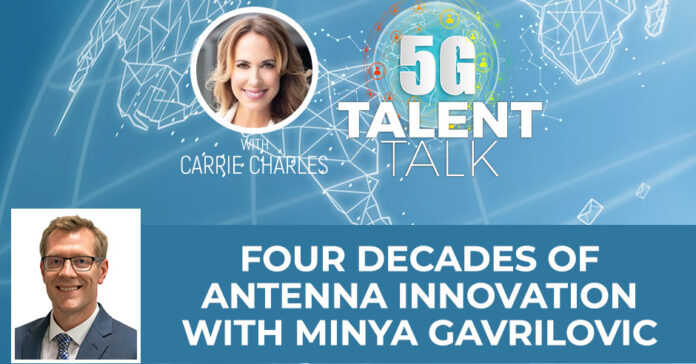Far superior than just possessing the technology to do something is possessing the ability to accomplish something. In the 5G space, ability is fundamental to innovation and being able to consistently grow and level up. In the latest episode, Minya Gavrilovic joins your host Carrie Charles as the two discuss how his company is changing the game when it comes to antenna innovation. Minya is the President and Chief Technology Officer of Galtronics USA — a leading antenna company serving multiple markets including wireless operators, fiber connectivity companies and home automation. Discover how Minya is training his staff on fundamentals and communication, and learn more about the company culture of being customer focused. Finally, find out the latest trends in 5G that have Minya excited; listen to the full episode below to learn more about Galtronics’ innovative designs!
—
Watch the episode here
Listen to the podcast here
Four Decades of Antenna Innovation with Minya Gavrilovic
My guest is Minya Gavrilovic. He is the President and CTO of Galtronics. Minya, thank you for joining me.
Thanks, Carrie. It’s nice to be here.
I’m excited to hear a little bit about your career path and how you got to where you are in the seat that you’re in.
Thanks for having me on this show. My career certainly wasn’t that conventional one. I do come from a technical background. I’m an engineer. I had a Bachelor’s in Engineering. In many ways, I’m a competitive guy. I decided to do a graduate degree in one of the hardest subjects that all electrical engineers hate, Electromagnetics, which leads us to the path of RFs and antennas. I got a graduate degree. I got a PhD from McGill University in Montreal. That’s up in Canada, where I live. I started as a design engineer in that field, which is very technical. There’s a large percentage of PhDs in the RFs and antennas field.
My first job was in the space industry at a company called MDA. That was a renowned antenna group in the world. It’s probably one of the best antenna groups in the world. They still are. It’s where I spent many years in design and working in the space business, designing antennas for space applications with mechanical, thermal, and structural engineers, which is a great environment. It’s a great place to cut your teeth and do a detailed design.
I did migrate to a different area. In 2007, I decided to leave that company and try something else. I moved into the telecom world at that time. I joined a small company in Ottawa, a two-hour drive to Montreal. That was in the telecom world but was also product management. It was a real shift for me and had nothing to do with the old company. I wanted something different.
Now, this got me in front of customers, in charge of marketing, and tried to do product definition, which was great for my career. It moved me onto the business side of things. I spent several years doing that. I moved into engineering leadership roles from manager to VP of Engineering roles within that same company or around the entire engineering group. I put it all together when I came to Getronics a few years ago as the Chief Technology Officer at that time.
Galtronics’ key strength is engineering what others can’t. Its secret sauce is not technology; it’s ability.
I put together that customer interaction with a technical background, married it together, and became CTO. Over the years, as things evolved, I took over PNL Company. I became the president as well. I still like to wear the CTO hat because it was what my background was, but I am the world leader of the company as well. A lot of times, I spent in detailed design, but also in front of the customer and sales as well. I put everything together now, and here I am.
I’m sure you’ll always be an engineer at heart.
I will never migrate too far from that. That’s for sure.
Tell me more about Galtronics, your products, the customers that you serve, and a little bit about how it’s structured.
It is very much an antenna company. It is an old antenna company. We’ve been around for many years. We’ve done a lot of different antennas. I’ll talk about all the different types, the ones that look like a walkie-talkie, through what we have now. We have three business units in general. We have one that does mobile antennas like for your cell phone. Headset antennas, we’re the number one supplier to one of the biggest smartphone suppliers in the world.
We do all-day antennas in there, from Wi-Fi to 5G antennas to Bluetooth, whatever you want that are in those devices. That is a standalone business unit run in Korea. We have another business unit that’s called the Embedded Antennas Business Unit. That covers a wide swath of applications. We go from applications to embedding antennas into IoT devices. It could be in your coffee maker to automotive applications to integrated 5G antennas, which we have and are delivering.
I think our bread and butter there is high-end home connectivity solutions like Wi-Fi 6E, eventually Wi-Fi 7. These things are important. The design of the antenna is huge in that field. Allowing super-fast connectivity once people start moving to gaming, the metaverse, and things like that at the home. That’s the second business unit. The third and last business unit is the one we call Wireless Infrastructure. It’s the closest one when we talk about 5G. That’s the telecom market. We design antennas that are standalone antennas for 4 and 5G applications.

We do things that are used in the DAS in-building, small cell, and the macro event space. Our customers are wireless carriers. Although we’re a global business, we are approved by the big top three Tier 1 carriers in the US. Those are our customers. As opposed to the customers for our embedded business, that tend to be the suppliers of the gateways, the extenders that are supplying the multiple system operators in the US and globally as well. In the infrastructure business, we’re working a lot with the end customer, whereas the other one’s more of an OEM-type business.
What are 5G technologies unique to Galtronics?
Our key strength at Galtronics is engineering what others can’t. One of our Tier 1 customers that we supply everything in the field asked us to do a very small antenna, a two-inch whip antenna. It was a small cell antenna and a small form factor. No one had been able to do it that worked well in a volume-type environment. They wanted LAA and License Assist technology built in there as well. We were able to do that in three months and get them a product in their hands.
That Tier 1 was so impressed by how quickly we developed it, not just the actual product, but it was a different technology than others. That defines a little bit about what our strength is and what’s unique to us. We’re best known for DAS and venue products at Galtronics, but we’re also a leader in the small cell space. We have a ton of small cell antenna canisters that are approved by the vendors. It’s probably one of the biggest ones in the space.
We have macro antennas. While we protect everything with patents, some companies market themselves by saying, “We have this technology.” We don’t have this technology. Our secret sauce is not the technology but it’s our ability. That’s our secret sauce. We can design anything. To give you an example, I brought a couple of physical examples.
It looks like a salad bowl, but it’s not. This is an indoor DAS antenna traditional that goes on a ceiling. It hooks upright on the ceiling somewhere and radiates downwards, and is in a directional way. This is a DAS product. We tried to do something that looks similar this way, but that’s distant. It’s barely thicker than a sheet of paper. It’s going to get installed in the ceiling, and you can barely tell it’s there. It’s serving the same purpose. At the end of the day, I won’t take offense to it. Antennas are ugly. This is less ugly. Whatever is less ugly is good. We have the small, thinnest in-class antenna now available to customers that we developed in 2021.
That’s covering 600 bands, all the FDD and TDD bands from 600 to 4.2 gigs band in this one antenna. SISO, MIMO, all these applications, but from the flip side, there are not a lot of companies that offer this. This is the size of a billboard. Unfortunately, physics tells me I can’t make this much smaller, but this is an AWS PCs 941 multi-beam antenna. It’s a macro event that radiates six different beams in six different directions. That’s existed before. We’re not the first ones to do multi-beam. It’s the best thing possible that those beams that people deploy with existing products tend to move around with frequency, and as they move with frequency, your performance is ruined.
Before you even get to the soft skills, you really need flexibility and understanding first.
We found a way to design the same without those beams moving. Some solutions do that which are much more expensive. This type of technology works well, but this is doing it at a price that the carriers can now afford with that huge performance improvement. On top of that, we’ve put it in a bad-ass case. We knew people and liked to listen to our customers. We knew that they put them up and take them down all the time.
There’s also a deeper effect. It is a regularization of the same. You see the corners, the bumpers. On top, there are these little U brackets that protect the connectors. You can’t see them as well. The handle is in the back. This thing’s a bit of a tank because, again, these are premium antennas. They go up and down on these temporary sites. As people have invested in buying them, they should protect their assets. We feel strongly about that. It’s something unique, but it’s not about that one technology. It’s about the ability to develop this technology. Multibeam is going to be part of our story. It’s going to be part of the 5G solution for us in the future. We’re glad that we have it, but we’re not stopping there. It’s the people.
You said that “It’s not the technology. It’s our ability to design anything.” That sounds like an exciting career for someone who is engaged in the future, especially for an engineer that’s looking for some cool projects. Let’s talk about the company culture of Galtronics. You mentioned people. What makes it a great place to work for your team?
Before I talked to the internal team, we always connected also to people, which is the customer. It sounds cliche. Everybody thinks of the customer. At the end of the day, we exist because of the customer. We try to stay close to the customer. I’m the President and CTO. I am regularly meeting the customer face to face. I’m not talking about other execs, VPs, and SVPs from the carriers. I’m talking about directors, managers, and RF engineers directly. I will go meet with them directly. I want to see them face to face because these are people in the trenches.
Not only are they making the decisions, but they’re the ones who are solving the problem. We’re trying to help them. We want them to know that we’re working with them in detail. Whatever company we work with, we have a tight relationship with them that they can contact us. That flows back into our company culture. We’re a very sales-driven and open culture. Our salesforce has a lot of access to engineering.
In many companies, it’s purposely siloed to protect, “They’re going to distract engineering team.” We try to do things in a way that we integrate the culture in that our engineers are becoming sales-focused and part of that decision-making process. We want our engineers working with our salespeople, even talking to customers. That’s a little bit rare. You don’t find that in a lot of companies. There are a lot of channels, and product management, which I know well, but we find this works well.
As an engineer, you can get close to the customer. You can see what the customer is doing and what they want because you’re the one developing the technology. In our company, they can expect to be part of the solution. They want to tuck away in a corner and never see anything possible, but that’s not what we encourage. Everybody’s part of the team here, whichever the business unit. We try to do that in both.

That’s part of this entire shift that we’re seeing in the workforce is that people with technical skills such as engineers and IT. They’ve traditionally, “Stay there. Do your work. You’re not going to interact with people necessarily.” What we’re finding in staffing is that we’re getting more and more requests for soft skills, for technical people to have soft skills. It’s important because they are customer-facing. It’s a new world. It’s interesting that you said that. You are a perfect example of that at a higher level. Do you see that as well? Technical people, there are more soft skills and people skills that are required now to be successful.
We are. I do want to see it more. What we see in terms of trends lately, the big one is COVID. This environment has changed it all for us. How do you keep people interested and engaged in this environment? Before we even get to the soft skills it’s allowing flexibility and understanding. Flexibility in working from home is part of our business. There are software companies it’s easy to work from home. Here, engineers design something on a computer and work with their colleagues who try to source parts and order them.
They build it in the lab. The engineers are working with technicians and assemblers to assemble it and then tune it. That’s an iterative process and transfer it to production to get it production-ready or seeds. That’s the connection between those parts, and product development can get slowed down online. Honestly, if anybody argued differently, I would challenge that. It doesn’t mean that you can’t get that flexibility. There are times when you can get that flexibility from working from home.
Things that we didn’t have available when I went through the process, it was new to me. I had never worked from home before. Understanding is something different. Understanding is it might be allowing someone to work from home. There are people on lockdown. There have been people who are scared and those who value their freedoms.
Whichever way you are, we have done enough as humans to understand that you need a job. What we try to do about these habits is we have protocols that we follow according to governments and whatever best practices. We do all that. Within those boundaries, we try to have an understanding that one employee might be scared, and maybe they have someone susceptible at home to COVID for servers or something. We try to accommodate them. Both people have that. It’s something we probably lack overall, and all of humanity knows a little bit more understanding. We try to do that. We know people are different. We think that helps.
Leaders in order to attract, retain and engage talent, need understanding and empathy. The way you said it was perfect because that’s what people need. They’re gravitating to companies that have that empathy and understanding. They’re leaving companies that don’t. I’m excited to hear that Galtronics has that heart of understanding and empathy. With telecom in the midst of digital transformation, are you seeing any new tech skills that are different than before that are needed now in our world, or maybe some on the horizon that, let’s say, someone listening is thinking, “I need to upgrade my tech skills or upgrade this certification. What do I need to have to be marketable in the future?”
Tech skills had gone one way that engineering now has things that were never there when I finished engineering in the ’90s. They have these hybrid programs where someone can do a little bit from one field to the other field. The combination of things makes things interesting. An example is mechanical engineering skills both together or someone who does hard work or knows how to program and do furthermore. Things that are traditionally siloed areas and skillsets will help come together in this age.
Don’t forget your fundamentals. They’re what allow you to be creative, to design things that haven’t been done before.
On the flip side, what I’m noticing that I’ve been a little disappointed by, and I blamed myself as an industry leader, is we see a lot of graduates coming from schools, especially PhDs, that are phenomenal and do some exceptional things. They come in and show us this amazing cake. It’s either the cake or the ice. It’s great. Do you know what flour you put in that cake? They’re missing some of the fundamentals. It’s not all their fault. There’s such a rush to get so much done that a little bit of the fundamental principles is lost.
We’d like to see some of that back because it’s the fundamentals that allow you to be creative and to design things that haven’t been done before. I always try to push my engineers or push onto their engineers is you’re not always going to find the answer in a published paper. It’s not going to happen. You have boundary conditions of stuff. You can do IP papers in public. That’s fine, but it’s your basis and understanding that’s going to allow you to be creative and design something that’s not there.
As people in the industry, we need feedback, especially in the world that we live in. That can’t be forgotten. That’s an important part. The last one, we don’t teach, and you mentioned before soft skills. Communication is huge. This is not unique, but as you probably know, there are a lot of engineers with quirky personalities. We are that for sure. Our communication is not great. People thought, “Now I’m working on Microsoft teams or Zoom. I don’t have to communicate as hard.” It gets that much worse.
That’s what I’ve seen. I’m not necessarily here. I think about Twitter. How toxic and explosive that can be. Why? Not everybody’s going to go on camera like you and I are doing. They’re off camera. The written word can be a little divisive, short sentences can be misinterpreted by colleagues, and things can go a different way than they would have been face to face. That’s not a good place to be. I’d love to look into this for our company is teaching people how to communicate properly via email. We don’t have to have a ten-page long email to communicate something or a straight-line sentence that may appear inflammatory.
We have divisions in China, Korea, the USA, and Canada, and work with people in Europe all over the place. We have different cultures, time zones, people, and education levels. How to deal with people, your communication would be huge. I haven’t seen a lot of proper communication in any company, and I think that should grow alongside the digital transformation.
Every time I speak, I suggest to people to take responsibility for their own training and education. Take communications courses and read books on communication. If you’re not getting it in school or your company, take that on. You’re going to learn and master that skill. You said this about communication because we kicked off a whole training series for our team at Broadstaff on communication. I was teaching communication skills and strategies because it is crucial in this world. Some candidates feel like, “If I have the experience and the skill, that’s it. I’m good.” It goes way beyond that. Hiring managers are asking and demanding good communication skills now. I agree with you 1000%. Have you seen over the years engineering change in telecom, or how has it changed?
I don’t know. I wouldn’t say it’s changed so much because I transferred two telecoms from space. I don’t know if it’s changed that much from the past, but I’ll tell you what drove me to this business. What I love about this business is it is about proximity to the customer, what I didn’t like about the space business. They are some of the best engineers I’ve ever met. I love my colleagues. They’re amazing in the space business. What I hated was you developed something, sold it to a prime contractor, and I never heard what it did or how it did. It’s done. I can’t see it. It’s gone in space.

In the telecom business, I get to talk to the customer who’s using the product, not the Ericsson’s and the kids. I’m talking to the operator who says,” We’ve done this, and it’s worked this well.” It pumps me up when I walk through an airport and see my own cell phone tower or a streetlight. I love that. A story went up to the previous company, setting up engineering, and I was walking down the street with my dog and my wife. I knew one of our tenants was on a cell phone tower nearby. It had a funky beam shape for whatever reason there was that we designed it into. The signal level would drop at a certain level.
I was walking and measuring with my phone. In the settings, you can measure the actual power you’re getting from the reception. I could recreate what the beam shape was like by walking on the street from my provider locally. It was so cool that I went, “This is data I’m getting on my mobile. That’s connecting me to the technology that we had developed.” I love that. That’s telecom. Especially in the antenna field, it’s not a black box. We’re getting to hear how it works.
On the Wi-Fi side, we validate our antennas through OTA testing and the test scores that we have. We do throughput testing. We’re not testing with their customer. The customer could be any person’s residence, but we’re doing the exact tests that as someone deploying an extender, am I getting good coverage? The throughput that we do those actual tests. The real-world performance feedback to the engineer is something that you can expect. That’s what I love about business.
We all want that sense of accomplishment and being able to see the results of the lives we’re changing, or the result of our work is so special and meaningful. What interesting trends do you see in 5G as it pertains to antennas?
The obvious one would be to integrate antennas to become integrated with radio companies. Another one would be the millimeter wave. Millimeter wave has its place. The trends we see with millimeter wave are the realities of physics. It’s a very high frequency in a very small way. That’s going to interfere with the bushes or branches. It doesn’t propagate well. It has a niche application. Unless you have a line of sight, we have a high gain antenna or an environment in which you have a clear line of sight. You’ve got to plan around the realities of the fence. I think carriers are starting to realize that. There was a lot of excitement, saying,” It’s going to be all in.” I think people have become much more pragmatic about that.
For the integrated antennas, we’re in the midst of it. People are deploying steel depending on the frequency, but mostly in the UFC band, a lower frequency that does propagate better. In that case, we do work on those types of antennas. I think there’s an excitement about those things, like a massive MIMO towards last in line. Your beams are moving up and down and left and right. It has an elevation forming. Think about it this way, you’re Jeff Bezos, and you want all your drivers to get there a little bit more efficiently, but I’m going to buy them Maseratis. Their Maserati goes 0 to 60 miles an hour in 3 seconds, but I can only go 35 miles an hour in that neighborhood.
These are remarkable. The gains from that balancing with the economics of other solutions can be done in a more cost-efficient manner. I think there’s a lot of excitement saying, “Let’s deploy this everywhere.” I think the economics are going to catch up a little bit with it, and that’s going to drive them to make other types of choices. That’s a trend that I think we will see, but they’re in the midst of this massive deployment. Another one for 5G, Orion, is big. Some people, I think, scoff at it, but with the players invested in it, the amount of money there. I know of at least 22 different new vendors.
What excites you shouldn’t be the products you’ve designed, it should be the products you haven’t designed yet.
Monster companies, you got to take it seriously, and will it get the incumbents to change the open standard? Will the carriers embrace them? The other thing that we have to talk about, the last one about 5G, is how about noncarriers? How about private networks, which are growing and could be a target? Private 5G is growing. That has its own set of requirements and different players in this game. All interesting things are happening. The thing that’s good for us is we can supply them all and work it all. It’s interesting how that pans out with a different customer base now and different radio vendors in the market.
What excites you about the future?
Certainly, the dreams of wireless in the ’90s are true now. Everything works. It’s more wireless devices. I’m a wireless guy now. That’s very exciting because we can play all these in this world. What excites me is the thing that people are scared about. What people are scared about in our industry, and we’ve been trying to help staff some positions. You find some salespeople. Our industry started moving in the ’90s. People were in the midst of it in the ’90s. There are a lot of people going outside the workforce that are retired. A lot of people are long in the tooth in this industry, and it’s a challenge. Replacing them or missing a big block of qualified staff.
What excites me is bringing other people on board. It’s going to be the youth. It defines everything, defines the countries and technology. The youth excites me. It’s the newcomers. The next generation is saying, “We’re working hand in hand with the people who’ve been around the block,” which I hope to continue to work on and not retire. Don’t retire, guys and gals. Stay in the workforce because it’s fun. We have a cool job. Working with younger people who are going to be the engine for growth is going to be critical.
What excites me, it’s not one product, and maybe this is a competitive nature. It’s not the one that I’ve designed. It’s the one that I have. That’s what drives me. That’s what keeps the fire burning. That’s what brings a person to work every day because, “What’s the one I haven’t even thought of yet?” I don’t get upset when a competitor comes up with something I didn’t. I think about what can I do that’s better? It’s thinking competitively like that. What can we do that’s different? Engineers, especially the way it is here in the US and Canada, we’ve got to use that creative ability to come up with new solutions that are going to make our customers more competitive against their competitors.
Let’s talk about the one you haven’t designed yet. If anything was possible, a blank slate, you could design anything right now. What would it be?
I don’t know if I have an answer for that. I’d love things to be multi-technology. If you go outside our business, back to the space business, there’s a whole huge problem with terminals and panels that go in people’s houses or vehicles that attract these constellations to know about that stuff. They were extremely expensive. Elon Musk has mentioned that. That’s one of the biggest challenges to SpaceX. The business case is going to be challenged and pressured if they don’t resolve the cost problem they have. Those antennas are very similar. What can we do in technology that pairs together different systems and pair together in some way technologically? That would be interesting. It’s wild. It may happen in the future, so that would be certainly interesting.

Let’s talk about the future of Galtronics and the vision.
Someone may say to the antenna companies that go, “What’s going to happen with antennas?” I think that’s mislabeling what may happen. I think there’s a lot of learning to be done and how we’re deploying the next few years. What is the customer base going to be like? Partnerships with people in different technologies, radio vendors, whoever, are part of the server. We do talk to potential partners to get into different areas that go beyond antennas, and that excites us. I do see that in our future. That said, our strengths are ones we have to double down on. If we think it’s going to be a be-all, end-all antenna, that you have a C-band multi and a massive model antenna that’s supplied by OEM, that you’re done.
Don’t forget about all that 600, 700, 800 spectrums, AWS, PCS, all this FTE that carriers spent billions on that are all different shapes and sizes. You can’t throw a massive antenna around that you want to use. With different types of customers coming in, like private 5G that aren’t necessarily the carriers only, they’re going to drive different requirements. What is that going to do? It’s going to drive us to have innovations for many different customers in a very different type of way.
What we’ve done best as a company is designing things, either super innovative or very quickly. That speed, what this industry was in the ’90s, which was designed like three models or a bunch of carrier design, get the same type of antenna to thousands and thousands of sites that are going to change. This is going to be the highest skew and high model environment for different applications. The companies that can adapt and do this quickly in an innovative way are going to succeed. That’s a bit of a sweet spot for Galtronics. I feel good about that. I think we’re going to continue to do that and evolve quickly, and the fact that we can is going to be an advantage in the future.
I’m sure you’re hiring. We talked a little bit about that earlier. Where can the audience go to learn more about Galtronics, the jobs available, all the wonderful products, and everything you’re up to?
Our website is a good place to start, Galtronics.com. We post our jobs. We are hiring engineers, salespeople, and other roles as well, on and off. We post on LinkedIn as well. We have a LinkedIn presence that we take advantage of sometimes locally, depending on where we hire, like Indeed.com or something like that. The website is great. We hired someone who cold-called us on the website. That was great, a unique talent. They approached us on our website through our Contact Us, and it made its way through. We’re going to get this person an offer. Don’t be shy. Come to us. We need people because it’s a great place to work. I think there are people who have a lot of fun here.
Minya, this has been wonderful. I learned a lot. I could talk to you forever. I love the way you used analogies, and it made sense to me. I appreciate you coming to the show. Thank you.
Thanks, Carrie.
Important Links
- Galtronics
- LinkedIn – Galtronics
About Minya Gavrilovic
 Minya Gavrilovic is the President and Chief Technology Officer of Galtronics USA, Inc. Galtronics is a leading antenna company serving multiple markets including wireless operators, fiber connectivity companies, and home automation.
Minya Gavrilovic is the President and Chief Technology Officer of Galtronics USA, Inc. Galtronics is a leading antenna company serving multiple markets including wireless operators, fiber connectivity companies, and home automation.
Since joining in 2017, he has held multiple roles including EVP of Innovation & Product Strategy, as well as Chief Operating Officer. Under Minya’s leadership Galtronics entered and became a leader in outdoor Small Cell antennas. Additionally, Galtronics has launched multiple innovative macro antennas, while fortifying its leading DAS & Venue antenna market position. In just the past few years, Galtronics was approved by all three major carriers in both the US and Canada.
Prior to joining Galtronics, Minya was VP Engineering and GM of CCI Antennas. In that role, he led the development of a portfolio of LTE macro antennas approved by Tier 1 network operators worldwide. Before CCI, Mr. Gavrilovic held leadership roles in engineering and product management at the Canadian Space Agency and TenXc Wireless (which later became CCI) and started his career as a RF design engineer at EMS Technologies (now MDA).
Minya holds a Ph.D. in Electrical Engineering from McGill University and has over 20 years of experience leading and developing wireless technology innovation.
Love the show? Subscribe, rate, review, and share!
Join the 5G Talent Talk Community today:

